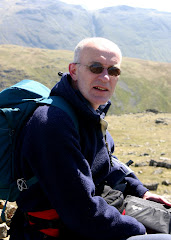On all the days the new route follows different routes to that taken by Wainwright and usually the differences are slight, to avoid busy road sections and to travel by more pleasant paths or bridle ways or, at worst, minor roads. Day 8 sees a wholesale variation to the route opted for by Wainwright. His aim had been to "...get to Appleby...twenty three miles away, across the desolation of Cross Fell."
The weather was against him in 1938 and reaching Leadgate, where he admitted that had this been the outward journey he would have carried on for Cross Fell, he yielded to the foul weather and proceeded to spend the entire day walking on roads to end it at Gamblesby after only 9 miles. Only on his next ninth day do the route again coincide south of Milburn.
So, ignoring the old route entirely (there is an appendix later in this chapter that shows Wainwright's route), day 8 sets off south from Alston on the east side of the river following the route of the Pennine Way. The path passes "Sillyhall" - the origin of the name would be interesting for it is still marked on the maps as "Low Sillyhall".

I make no excuses for following the Pennine Way as the aim of this guide is to be able to spend more time in savouring the history than in finding the way through a minuteae of boring right turns and left turns. The following of such a major way will present little difficulty and especially on a day navigating over Cross Fell the more waymarkers the better.
The route continues to Garrigill passing through the village before turning right up the old miners' track. The track is distinct and would have been so in 1938 so it was a surprise to me that Wainwright hadn't followed it; I suspect that he was at a low ebb leaving Alston with the day getting nearer to his being back in the real world.
Garrigill had grown up around the lead miners so any history specific to the village would be useful.
When I walked this way in 1998 I saw no obvious path at the point where the Pennine Way takes a more direct route so I followed the safety of the track for its route was clear.

To either side of the track as it winds up the wild moorland lies the evidence of the old mining works with shake holes scattered over the whole scene and disused shafts and lead hushes. It is advisable to make sure that the path is followed and not strayed from. You could be missing for a long time up here before anyone found you.


Purists might say that following a road is a cop out but this has been a hard-enough day which has followed earlier hard days so a gentle descent seems fair.

APPENDIX:


Day 8 has seen the complete divergence from the original but should have proved to be a delightful day crossing the Pennines highest summit and having seen such desolate surroundings where it is hard to imagine that people would earn thir living.


No comments:
Post a Comment